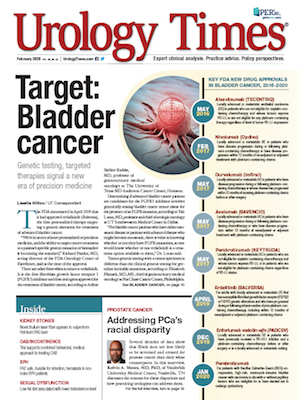Publication
Article
Urology Times Journal
Drug-coated balloon found efficacious for strictures
Author(s):
“If the long-term results prove to be as positive as the short-term results, then this could provide an intermediate option for patients with recurrent bulbar urethral strictures," says Sean P. Elliott, MD, MS.
Use of the Optilume paclitaxel-coated balloon appears to be a safe and effective method for the treatment of recurrent bulbar urethral strictures, producing a low 12-month recurrence rate and no treatment-related serious adverse events, according to researchers in Minnesota, Virginia, and Latin America.
They reported 1-year data on this novel drug-coated balloon (DCB) at the 2019 AUA annual meeting in Chicago that showed the treatment is safe and the device produces urethra luminal gain that achieves significant clinical results with meaningful increased maximum urinary flow rate (Qmax) and decreased International Prostate Symptom Score (IPSS).
The authors conducted a multicenter, non-randomized clinical trial (NCT03014726) with this device, which combines mechanical balloon dilation with a paclitaxel drug coating. The DCB is designed to limit hyperactive cell proliferation and subsequent fibrotic scar formation in an effort to delay or prevent stricture recurrence. The authors note that paclitaxel has been used extensively in cardiovascular medicine for prevention of restenosis following angioplasty and/or stenting.
Also see - Robotic ureteroscopy: The future of stone management?
The ROBUST I study included 53 men with a single recurrent bulbar urethral stricture. All the men had undergone one to three previous endoscopic treatments. However, the majority were performing self-dilation at home. Following treatment with the DCB, the 12-month anatomic success rate (defined by urethral lumen ≥14F) was 70%. No treatment-related serious adverse events within 90 days following the procedure were reported.
“I was not surprised by any of the findings. I expected the drug-coated balloon to perform as well as or better than an uncoated balloon,” said study investigator Sean P. Elliott, MD, MS, professor and vice chair of urology at the University of Minnesota, Minneapolis.
In this current study, men with bulbar urethral strictures ≤2 cm were enrolled at four study sites. All the men underwent mechanical balloon dilation or direct visualization internal urethrotomy just prior to DCB treatment. The authors assessed patients at 2 to 5 days, 14 days, 3 months, 6 months, and 12 months after treatment. They used anatomic success as the primary efficacy endpoint, and it was defined as urethral lumen ≥14F.
The study revealed that anatomic success was achieved in 32 of the 46 men (70%; 95% CI: 54-82%) at 12 months. Among the 14 patients who failed to meet the primary efficacy endpoint, seven were due to cystoscopic recurrences, five were de to retreatments, and two patients exited the study early due to symptom recurrence.
Next: Success rate ‘encouraging’Success rate ‘encouraging’
“Our 70% success rate is encouraging. If they were treated with an uncoated balloon, I would have expected it to be closer to far less than 70% and closer to 10% at 1 year. The initial results are encouraging. The average number of prior endoscopic treatments in our cohort was 1.7. Historically, such a group should have a low success rate with this, their third dilation. So compared to historical controls, the Optilume performed well,” Dr. Elliott told Urology Times.
He said there were no severe urinary adverse effects and the moderate side effects that did occur were not of serious concern. Overall, the most common adverse events were urinary tract infection (15%), fever (12%), acute urinary retention (8%), headache (8%), and dysuria (6%). The majority were classified as mild (58%) or moderate (38%), based on the Common Terminology Criteria for Adverse Events.
Read: Stone management often falls short
In this cohort of 53 men, the mean age was 51 years (range, 22-81 years) and stricture etiology was due to traumatic (51%), iatrogenic (45%), and idiopathic factors (4%). The men were treated between Nov. 29, 2016 and Sept. 9, 2017. Mean IPSS and mean Qmax were also significantly improved at 1 year. IPSS improved from 25 to 5 (p<.05) and Qmax from 5 cc/s to 20 cc/s (p<.05).
The authors now plan to follow this group of patients for 5 years and will report long-term success rates as they become available.
“If the long-term results prove to be as positive as the short-term results, then this could provide an intermediate option for patients with recurrent bulbar urethral strictures. By intermediate, I mean it would be an alternative that would sit in between urethral dilation and urethroplasty,” Dr. Elliott said.
Urotronic provided funding for the study.































